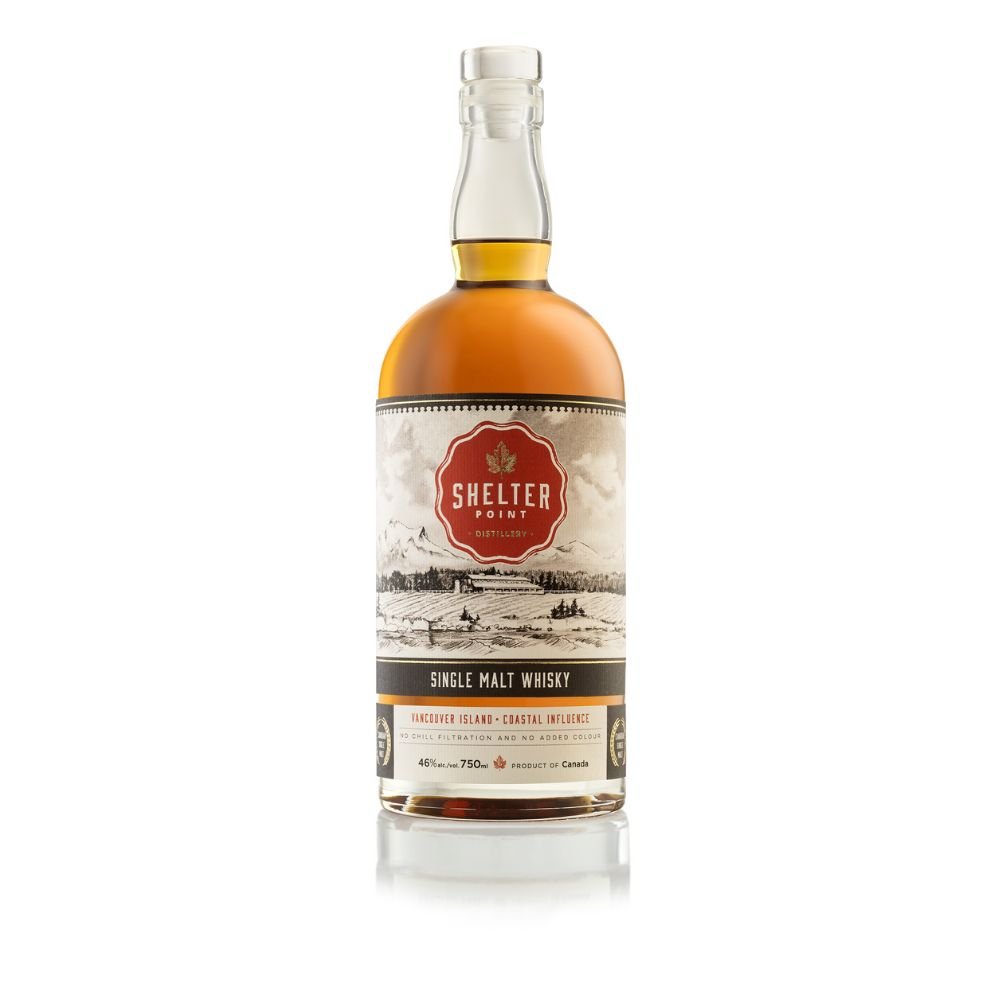Shelter Point Distillery, British Columbia
Shelter Point Distillery, Campbell River, British Columbia; shelterpoint.ca
The Shelter Point Distillery, located about a three hour drive up the Vancouver Island coastline from Victoria, wasn’t the first single malt distillery in Canada, or even first off the mark in British Columbia. But it may be argued that it was, and in many ways remains, the most patiently determined.
The idea for the distillery was born in 2006 when third generation farmer Patrick Evans decided that a good use for the barley he was growing on his 380 acres of farmland would be to distill it into whisky. Thereafter began two years of research with his friend and fellow farmer, James Marinus, touring distilleries in Scotland while placing special emphasis on those which incorporated an aspect of farming into their production. This was followed by a further two to three years of construction, with most of the work being done all in-house, right down to the milling of the wood used to renovate the barns on the farm.
The end result was one of the most aesthetically pleasing distilleries in Canada, accented by copper pot stills made by Forsyths of Scotland. But still, there remained the issue of whisky production.
Photo courtesy of Shelter Point
Unlike any number of Canadian craft distilleries, under the direction of head distiller Marinus, Shelter Point elected not to rush their spirits to the marketplace, instead supporting the endeavour with the farm while waiting for their whisky to mature, and only released their first whisky some five years later. That whisky is today known as the Classic Single Malt and is released after seven years of aging, a fact that will be reflected in newly designed labels arriving in 2024.
A change in organization took place in January, 2022, with the family-owned, Vancouver-based Nelson Investments assuming majority control of the distillery and Patrick retaining full ownership of the farm. Co-operation between the two entities remains key, however, with the farm supplying up to 90% of the distillery’s barley needs, supplemented when necessary by other sources for BC-grown grain.
Unusually, Shelter Point can claim not just agrarian, but also coastal influence, with farmland that supplies some 90% or more of the distillery’s barley and a warehouse only one kilometre from the shoreline. Add a setting that must certainly qualify as among the most beautiful in North America and you have a destination distillery par excellence.
More than just whisky is produced at Shelter Point, and more whisky than what is reviewed below, but I elected to focus upon the following three spirits both at the distillery’s request and because I feel they best represent both the distillery’s impressive present and remarkable potential for the future.
Photo courtesy of Shelter Point
Shelter Point Classic Single Malt (46%): In the eighteen months that have passed since I made the notes contained in my British Columbia single malt round-up, this whisky seems to have only gone from strength to strength. Although still not chill-filtered, the light haze is gone from its brilliant gold countenance, and the aroma seems slightly less fruity and more Maritime-influenced, although there remains a definite note of melon in the fruitiness, alongside bright citrus, toasted grain, a whiff of seashore and even a soft waft of smoke, or at least charred oak. The palate entry is honey-ish and sweet, becoming more a mix of fruit flavours and baking spice on the mid-palate – melon, mango, and orange alongside nutmeg- and cinnamon-accented toffee – and drying rather wonderfully to an appetizing spiciness. An ideal afternoon or aperitif whisky.
91 ($78)
Shelter Point Aged 10 Years Single Malt Whisky (46%): A shade darker than the classic, the 10 year old is similarly bright and golden, bereft of haze, but with a more dense, less youthfully bouncy aroma, as befits its more advanced age. Gone are the bright citrus and smoke, replaced by more oak influence in the form of cooked vanilla, charred wood, and slightly overcooked toffee, along with stewed stone fruit – plum, apricot—and a hint of raisin. The flavour, too, has grown in depth and intensity, losing some of that bright fruitiness and replacing it with off-dry notes of toffee mixed with orange marmalade and fruit cake, accompanied by hints of candied ginger, buckwheat honey, and allspice, all leading to an oaky, bone dry finish. Bold enough for after-dinner – or even pairing with roast turkey or root vegetables – but also a satisfying sipper at the end of the day.
90 ($120; limited release)
Shelter Point Aged 12 Years Single Malt Whisky (46%): A shade and a half darker still, the 12 year old has developed greatly, evolving into a whisky that seems far more mature than its mere dozen years of age. The bad news for lovers of Maritime-influenced whiskies is that the seashore character is much diminished from what could be found in the Classic. The good news is that what has emerged in its place is far more interesting, a mix of stewed fruits – orange, pear, peach, and plum, perhaps with a pinch of sea salt added – and vanilla-accented oakiness, with an intriguing touch of what Cognac drinkers would refer to as rancio, that slight but so appealing whiff of oxidized nuttiness. On the palate, the attraction of maturity continues, with a bit of marzipan and marmalade up front leading to a complex mix of stewed and dried fruit – there is quite a bit going on, but stewed plum, date, and dried mandarin orange stand out – blending seamlessly with vanilla, toffee, and a hint of cocoa. The oak returns on the finish, but curiously only off-dry, rather than the intense dryness of the 10 year old, with long and lingering vanilla and brown spice. Something to be savoured at the end of the night.
93 ($120; limited release with plans for more regular availability)
Comparison: The amount of maturity Shelter Point has coaxed out of their various malts is nothing less than remarkable, with the 12 year old in particular coming across more as a whisky in its high teens than tweens. Even the Classic, for all its brightness and vivacity, seems more an 8 or 9 year old than the 7 year old it is, and the 10 is likewise showing age and complexity beyond its statement.
Although presumably crafted from the same grain bill in the same fashion, these are each much different whiskies with different roles to fill, from afternoon pick-me-up to satisfying nightcap. I am told that while the 10 year old was a one-off limited release for which continued production is not planned, the 12 year old is expected to return





